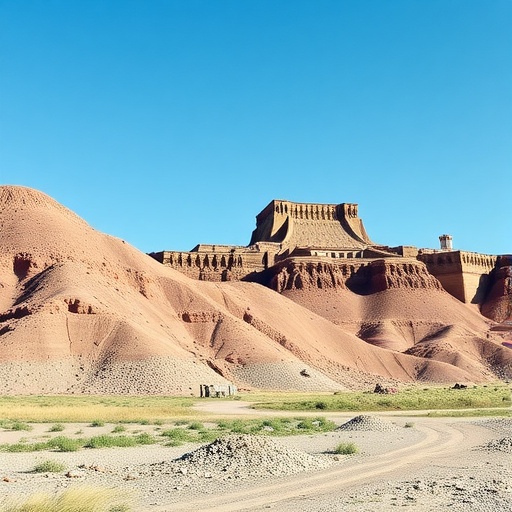In a groundbreaking study that sheds new light on environmental safety and public health, researchers have conducted a detailed radiological assessment of rock-based building materials sourced from the Kurdistan region of Iraq. This comprehensive investigation focuses on the concentrations of primordial radionuclides and radon emanation rates, addressing concerns that linger around the safety of commonly used construction materials in regions with notable geological activity.
Building materials derived from natural rocks often harbor trace amounts of radionuclides—radioactive elements that have existed since the Earth’s formation. These primordial radionuclides include uranium-238, thorium-232, and potassium-40. Though typically present in low concentrations, their activity can lead to the generation of radon gas, a recognized health hazard linked to lung cancer upon prolonged exposure. The relevance of this research lies in its direct implications for indoor air quality and long-term radiological risks in residential and commercial environments.
The study employs rigorous radiometric techniques to quantify the radioactivity levels in various rock samples collected from quarries and construction sites throughout the Kurdistan region. These measurements are vital as they provide empirical evidence of both the elemental concentrations within the materials and the radon exhalation rates that might influence indoor environments once the rocks are transformed into building components like tiles, bricks, and aggregates.
One of the most striking findings reveals that while uranium and thorium concentrations vary across samples, radon emanation rates correlate strongly with uranium content, aligning with the known geochemical behavior of these radionuclides. This correlation underscores the necessity for region-specific radiological evaluations, given that universal standards might overlook localized geological anomalies that elevate health risks.
The methodology integrates gamma spectrometry for the detection of radionuclide concentrations, ensuring highly sensitive and accurate readings. Such precision is crucial, considering the typically minute quantities of these radioactive isotopes embedded in geological materials. Additionally, radon exhalation was measured using accumulation chambers, mimicking real-world scenarios where radon gas could build up in enclosed indoor spaces.
Crucially, the researchers contextualize their data by comparing the measured radioactivity levels against international safety benchmarks, such as those recommended by the International Atomic Energy Agency (IAEA) and the United Nations Scientific Committee on the Effects of Atomic Radiation (UNSCEAR). The comparisons indicate that some rock materials, while generally within safe limits, still exhibit marginally elevated values necessitating cautious usage or mitigation strategies.
These findings carry significant implications for the Kurdistan region, where rapid urban development has accelerated the demand for natural stone in construction. Without proper radiological screening, such practices risk inadvertently exposing populations to chronic low-dose radiation, with possible long-term health consequences. The call to action is clear: standardized procedures must be adopted for assessing and regulating the radioactivity of building materials at extraction points and before mass distribution.
Furthermore, the study invites renewed discussions on architectural design that accounts for radon mitigation, including ventilation strategies and material selection to minimize indoor radon accumulation. This aspect is particularly crucial in regions with colder climates or modern buildings designed for airtightness, conditions under which radon tends to concentrate.
Beyond its regional focus, the research serves as a model for similar assessments worldwide, especially in territories with abundant natural stone resources. It exemplifies the integration of geochemical analysis with health physics to create a multidisciplinary understanding of environmental radiation exposure.
The research’s broader scientific context touches on geological evolution, as the uranium and thorium distributions reflect underlying tectonic and magmatic histories. This interrelationship between earth sciences and public health exemplifies how foundational geological processes can manifest in tangible human risks centuries later.
In conclusion, this pioneering study from the Kurdistan region underscores the critical need for vigilance when utilizing natural rock materials in construction. By meticulously mapping radionuclide presence and radon potential, the researchers have laid the groundwork for safeguarding public health against invisible radiological threats. Their work highlights the often-overlooked intersection of geology, materials science, and epidemiology, urging stakeholders to prioritize radiological evaluations in the expanding construction sector.
The impact of this research extends beyond material safety; it challenges policymakers, urban planners, and construction engineers to incorporate radiological considerations into standards and codes. Only through such integrative approaches can the built environment evolve in harmony with human health imperatives and geological realities.
As the Kurdistan region continues to thrive economically, the insights gained here will be instrumental in ensuring sustainable and safe development. Monitoring programs inspired by this study could become standard practice, creating safer living spaces and fostering public awareness about natural radiological hazards.
Ultimately, this landmark research exemplifies how detailed scientific inquiry into seemingly mundane materials can unearth critical health insights. It acts as a clarion call for increased research funding, public education, and international collaboration aimed at addressing the silent challenge of natural radioactivity embedded within the walls that shelter communities worldwide.
Subject of Research: Radiological assessment of primordial radionuclides and radon exhalation rates in rock-based building materials from the Kurdistan region of Iraq.
Article Title: Radiological impact of primordial radionuclides and radon rates in rock-based building materials: Kurdistan region of Iraq.
Article References:
Othman, S.Q., Namq, B.F., Hussein, Z.A. et al. Radiological impact of primordial radionuclides and radon rates in rock-based building materials: Kurdistan region of Iraq.
Environ Earth Sci 84, 485 (2025). https://doi.org/10.1007/s12665-025-12468-x
Image Credits: AI Generated




